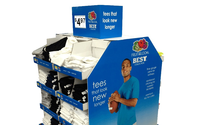 As beacons evolve, so too does the way marketers use them.
As beacons evolve, so too does the way marketers use them.
Once started out as small, battery-powered, radio-transmitting devices, beaconing technology is being integrated and
incorporated into other things.
Beaconing technology is being incorporated into lighting and Wi-Fi access points in large stores, as I wrote about here a while back (Beacons, GPS, Wi-Fi Combo: The New Mobile Presence).
And now, without much
fanfare, beacons are being built into fixtures arriving at retail stores.
Even more interestingly, the beacons are not being touted.
Shelfbucks, the Texas company that installed
beacons in GameStop stores last year, just inked a deal to partner with Great Northern Instore, which designs and provides in-store displays for brands including Kraft, 3M, United Hardware, SC Johnson
and Logitech.
Beacons will be pre-packaged inside the corrugated product displays before they’re sent to retailers for installation.
The key here is that beacons are becoming
part of physical structures inside stores rather than becoming a later add-on.
A major twist here is that beacons are not mentioned in any of the marketing materials for the venture.
I
view this as a major positive move for beaconing, since most consumers have little interest in (if even awareness of) actual beacons.
The hidden sensors in the store displays are not intended
to barrage passing shoppers with promotions or messages, as I saw in the GameStop approach last year. In those displays, signage suggested that if a shopper wanted more information they could go near
the display and tap into their smartphone, where beacon-triggered information was presented. But they had to essentially ask for it, as in a pull vs. push messaging approach.
So rather than a
general beacon opt-in when entering a store, where a shopper has no idea what’s coming next for messaging, GameStop shoppers actively said ‘this is what I want.’
The other
part of the beacons-inside-displays approach is that the beacon couldn’t be any closer to the specific products, which are on the physical displays, such as at a store aisle endcap.
If a
passing shopper doesn’t request information, the beacon still can capture data, including volume of passing traffic or dwell time.
Beacons are hardly going away. They will be less seen,
but more impactful.